
What Is A Fixed Asset Register?
- Purchase date
- Purchase price
- Description of the asset
- Location of the asset
- Serial number
- Value
- Insurance information
- Warranty information
- Supplier
- Owner
- Maintenance schedules
- Users
- State of repair
Fixed assets can be anything from tables and chairs to computer equipment, they are typically longer term investments that provide value to the business but depreciate over the years. Traditionally, a fixed asset register was kept on paper by a bookkeeper, with the introduction of Excel this moved to digital spreadsheets, and now with asset tracking software you can keep these records online. An online fixed asset register gives you greater levels of accuracy and automation. Every time an asset is scanned its location is automatically updated.
Why Your Business Needs A Fixed Asset Register
Correct Balance Sheets
Lower Insurance Premiums
Inventory Management

Centralised System
itemit’s Fixed Asset Register Solutions
If you would like to learn more about itemit’s asset tracking software, contact our friendly and helpful team today. You can reach them at team@itemit.com. Alternatively, you may want to consider signing up for our 14-day Free Trial to find out just how well itemit’s software can work for you. We’re confident that you will love the software’s features and how it can improve the day-to-day running of almost any business.

Try itemit
Choose a better way to track your assets. Start your free 14-day trial now!

Keep Learning
itemit Blog
Tips, guides, industry best practices, and news.
The Role Of Your Asset Register In Risk Management And Contingency Planning
What role does your fixed asset register play in risk management and contingency planning? Read our latest post now to find out!
The Role Of An Asset Register In Financial Reporting And Audit Compliance
How can an asset register app help with financial reporting and audit compliance? Check out this article now to find out!
The Impact Of An Asset Register On Asset Utilisation And Cost Management
Regardless of what asset register format you use, a digital format can have an impact on asset utilisation and cost. Read this article to learn more!



